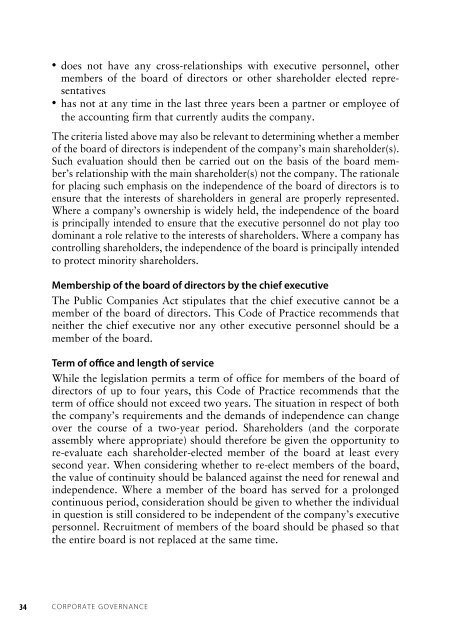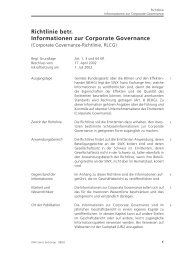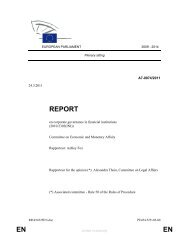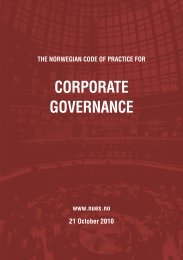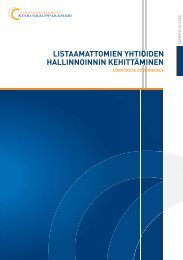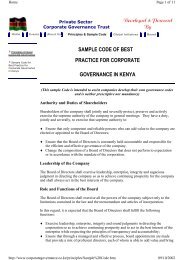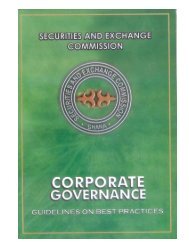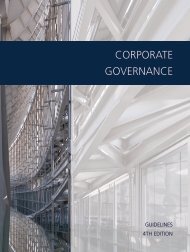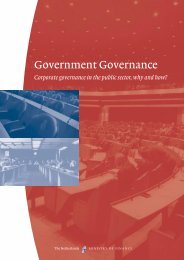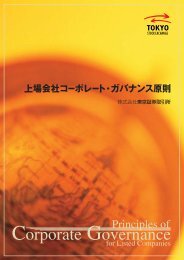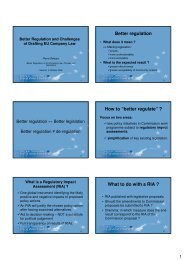• does not have any cross-relationships with executive personnel, othermembers <strong>of</strong> the board <strong>of</strong> directors or other shareholder elected representatives• has not at any time in the last three years been a partner or employee <strong>of</strong>the accounting firm that currently audits the company.<strong>The</strong> criteria listed above may also be relevant to determining whether a member<strong>of</strong> the board <strong>of</strong> directors is independent <strong>of</strong> the company’s main shareholder(s).Such evaluation should then be carried out on the basis <strong>of</strong> the board member’srelationship with the main shareholder(s) not the company. <strong>The</strong> rationale<strong>for</strong> placing such emphasis on the independence <strong>of</strong> the board <strong>of</strong> directors is toensure that the interests <strong>of</strong> shareholders in general are properly represented.Where a company’s ownership is widely held, the independence <strong>of</strong> the boardis principally intended to ensure that the executive personnel do not play toodominant a role relative to the interests <strong>of</strong> shareholders. Where a company hascontrolling shareholders, the independence <strong>of</strong> the board is principally intendedto protect minority shareholders.Membership <strong>of</strong> the board <strong>of</strong> directors by the chief executive<strong>The</strong> Public Companies Act stipulates that the chief executive cannot be amember <strong>of</strong> the board <strong>of</strong> directors. This <strong>Code</strong> <strong>of</strong> <strong>Practice</strong> recommends thatneither the chief executive nor any other executive personnel should be amember <strong>of</strong> the board.Term <strong>of</strong> <strong>of</strong>fice and length <strong>of</strong> serviceWhile the legislation permits a term <strong>of</strong> <strong>of</strong>fice <strong>for</strong> members <strong>of</strong> the board <strong>of</strong>directors <strong>of</strong> up to four years, this <strong>Code</strong> <strong>of</strong> <strong>Practice</strong> recommends that theterm <strong>of</strong> <strong>of</strong>fice should not exceed two years. <strong>The</strong> situation in respect <strong>of</strong> boththe company’s requirements and the demands <strong>of</strong> independence can changeover the course <strong>of</strong> a two-year period. Shareholders (and the corporateassembly where appropriate) should there<strong>for</strong>e be given the opportunity tore-evaluate each shareholder-elected member <strong>of</strong> the board at least everysecond year. When considering whether to re-elect members <strong>of</strong> the board,the value <strong>of</strong> continuity should be balanced against the need <strong>for</strong> renewal andindependence. Where a member <strong>of</strong> the board has served <strong>for</strong> a prolongedcontinuous period, consideration should be given to whether the individualin question is still considered to be independent <strong>of</strong> the company’s executivepersonnel. Recruitment <strong>of</strong> members <strong>of</strong> the board should be phased so thatthe entire board is not replaced at the same time.34 CORPORATE GOVERNANCE
In<strong>for</strong>mation on members <strong>of</strong> the board <strong>of</strong> directors<strong>The</strong> annual report should provide key in<strong>for</strong>mation on members <strong>of</strong> the board<strong>of</strong> directors such as their expertise and independence and their record <strong>of</strong>attendance at board meetings. In<strong>for</strong>mation on individual members shouldinclude details <strong>of</strong> their age, education and work experience, and state howlong they have been a member <strong>of</strong> the company’s board. In<strong>for</strong>mation shouldalso be provided on any additional work a member has carried out <strong>for</strong> theWhere a company has a corporate assembly, the members <strong>of</strong> the board <strong>of</strong> directors areelected by the corporate assembly, cf. Asal. § 6-37. If, by agreement with its employees, acompany with more than 200 employees does not have a corporate assembly, certain <strong>of</strong> theduties <strong>of</strong> the corporate assembly are transferred to the board <strong>of</strong> directors, including the election<strong>of</strong> the chairman <strong>of</strong> the board, cf. Asal. § 6-1, second paragraph, § 6-37, fourth paragraph,and § 6-12, fifth paragraph. Where a company does not have a corporate assembly, employeeshave the right to elect members <strong>of</strong> the board <strong>of</strong> directors pursuant to Asal. § 6-4. Bothsexes must be represented on the company's board <strong>of</strong> directors in accordance with the provisions<strong>of</strong> Asal. § 6-11a. At least half the members <strong>of</strong> the board <strong>of</strong> directors must be citizens<strong>of</strong> and reside in an EEA country unless the Ministry <strong>of</strong> Finance grants a specific exemption, cf.Asal. § 6-11. Members <strong>of</strong> the board <strong>of</strong> directors serve <strong>for</strong> a term <strong>of</strong> two years unless the articles<strong>of</strong> association stipulate a different term <strong>of</strong> <strong>of</strong>fice, cf. Asal. § 6-6. For some companies, thecorporate assembly is replaced by a board <strong>of</strong> representatives, and the board <strong>of</strong> representativeselects the members <strong>of</strong> the board <strong>of</strong> directors, cf. <strong>for</strong> example the Commercial Banks Act(Forretningsbankloven) § 9 and the Insurance Act (Forsikringsvirksomhetsloven) § 5-4.Pursuant to the “Listing rules <strong>for</strong> equities on Oslo Børs”, it is a listing requirement that at leasttwo <strong>of</strong> the shareholder elected members <strong>of</strong> the board <strong>of</strong> directors are independent <strong>of</strong> thecompany's executive management, material business contacts and the company's largershareholders. In addition, the Listing Rules specify that no member <strong>of</strong> the company’s executivemanagement may be a member <strong>of</strong> the board <strong>of</strong> directors. Oslo Børs may grant exemptionsfrom these requirements in special circumstances.<strong>The</strong> board <strong>of</strong> directors shall itself elect its chairman if the chairman has not been elected bythe general meeting, cf. Asal. § 6-1. If the company has a corporate assembly, the corporateassembly shall elect the chairman <strong>of</strong> the board <strong>of</strong> directors cf. Asal. § 6-37, first paragraph. Ifit has been agreed pursuant to the Public Companies Act that the company shall not havea corporate assembly, the board <strong>of</strong> directors must elect its chairman, cf. Asal. § 6-1, secondparagraph.<strong>The</strong> chief executive cannot be elected as a member <strong>of</strong> the board <strong>of</strong> directors, cf. Asal. § 6-1,third paragraph.Members <strong>of</strong> the board <strong>of</strong> directors shall serve <strong>for</strong> a term <strong>of</strong> two years, cf. Asal. § 6-6. <strong>The</strong>period <strong>of</strong> <strong>of</strong>fice may be fixed <strong>for</strong> a shorter or longer term in the articles <strong>of</strong> association, but not<strong>for</strong> a term <strong>of</strong> more than four years.<strong>The</strong> Auditing and Auditors Act § 4-2, first paragraph, cf. § 4-1, second paragraph, item 4,stipulates that no one may be appointed as auditor <strong>of</strong> a company if any other auditor orsenior employee <strong>of</strong> the accounting firm <strong>for</strong> which he or she works, or any member or deputymember <strong>of</strong> the accounting firm’s corporate bodies, is a member or deputy member <strong>of</strong> anycorporate body <strong>of</strong> the company in question.35 CORPORATE GOVERNANCE


